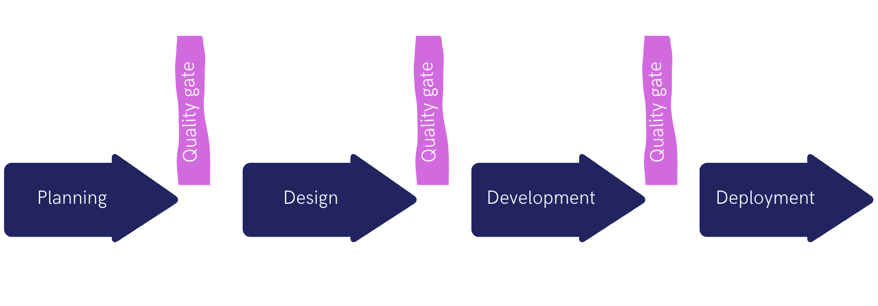We all know how important managing software quality can be to improving business impact. It should come as no surprise, then, that having strong Quality Assurance (QA) teams and systems in place is a must for tech-focused businesses. One of the most useful tools in the Quality Assurance arsenal is that of Quality Gates. Read on to learn what they are and how to use them.
What are Quality Gates?
In traditional project management terms, Quality Gates are benchmarks used throughout projects to ensure that everything is kept on track. Usually, they take the form of simple checklists that are set up during planning to ensure that the requirements are being met at a quality that is sufficient to proceed to subsequent stages.
Applied to software development, Quality Gates are an important tool in quality management. They are used to ensure that projects are meeting certain benchmarks in line with customer requirements at critical junctures in the software development life cycle (SDLC).
 Quality Gates in Agile Software Development?
Quality Gates in Agile Software Development?
In software development, Quality Gates are used either to manage stages of development at the project level or to manage code quality in development.
In Agile terms, they are like checklists for confirming deliverables are meeting defined requirements throughout the development process. Usually, these documents are defined and managed by project leaders or technical leads. They can be executed as meetings or reviews involving participants.
Code Quality and Quality Gates
When it comes to software testing, Quality Gates are one of the tools used by Quality Assurance Engineers to help manage code quality. Typically, they act as code reviews that prevent low-quality code from proceeding further down the development pipeline.
When new features or modules arrive at a Quality Gate, they can proceed to the next stage of development if they meet the defined requirements. However, when code doesn’t meet the established criteria, issues may be flagged, and the module is returned to development for debugging or to be otherwise improved.
The process is iterative and can be customized as per the needs of the development process.
When to use Quality Gates
Low-quality code becomes more difficult and more costly to remedy the further down the development pipeline it progresses. If poor quality code makes it into production, the cost of resolving issues that arise can be up to 6 times greater than fixing it in development. Resolving quality issues early on, therefore, is a good way to reduce unnecessary costs and improve ROI from development.
Creating Quality Gates optimizes the QA process by aiding in test automation. Smooth development and testing integration are important for supporting more efficient build and release cycles. Quality management automation is an integral part of optimizing modern development processes. Software methodologies like Agile, DevOps, or Continuous Integration/Continuous Development (CI/CD) promote agility and expedient releases, but speed can often come at the cost of quality.
In DevOps especially, the need for integrating development efforts with IT operations has made continuous testing a key part of SDLCs. With automation, testing can be carefully planned and implemented throughout the entire development pipeline. Quality Gates can be set up in line with customer requirements at key points in the development pipeline.
5 tips for better Quality Gates
While it may seem like the silver bullet for software quality issues, remember that quality always comes at a price. Automation strives to reduce costs and make processes more efficient, but even setting up and implementing automated Quality Gates takes time and resources. That’s why this process must be carefully managed and optimized.
Here are our tips for getting the best out of Quality Gates in your QA efforts.
1. Limit Quality Gates to necessary development stages
While such quality measures seem simple in concept, automating them can become very complex when speed is a deciding factor in the development process. Adding more gates increases complexity in testing, leading to longer pipeline execution times.
Managing where they are included in your QA process needs to be deliberate with attention for balancing time, complexity, and cost against ROI. Limiting the number of such gates to key handover phases in the development pipeline can help reduce complexity.
2. Quality Gates don’t have to be sequential
As software projects become bigger, more development pipelines may be needed to contribute to overall product delivery. Rather than setting up testing in sequence, consider parallel testing or overlapping testing. This way you can have multiple concurrent pipelines working towards the same goal with Quality Gates managing code quality at key stages.
To achieve success with these methods, however, it’s a good idea to coordinate testing as an ongoing process with development teams. Bear in mind, development teams and testers may need some training to be able to work together to smoothen the process.
3. Improve collaboration between QA and development teams
With “shift-left” testing, QA engineers need to support developers throughout the development pipeline. This can mean providing training, knowledge, or feedback on testing and quality assurance tools to help developers better understand the process. Making the testing process more transparent improves efficiency and effectiveness in debugging efforts.
Before implementing any Quality Gates or tests, QA professionals must secure cooperation and buy-in from the rest of the teams involved. This means communication and collaboration are especially important between teams. Implementing a DevOps methodology generally improves communication and efficiency between teams in the SDLC.
4. Automate for success with Artificial Intelligence
Automated testing is a great option for carrying out repeatable tasks. In some cases, QA engineers can automate close to 100% of the testing process, giving them more time for supporting the development process. Using the right tools for the job can make a world of difference. Artificial Intelligence (AI) solutions are a great way to improve efficiency in modern SDLCs.
With AI-driven automation, QA engineers can customize detailed code quality tests and set up Quality Gates aligned with software requirements. AI tools can learn from the results of tests to improve performance, making smart decisions about what code is acceptable or not based on historical data. For tips on hiring QA automation engineers, click here.
Code Quality and Visibility
At the end of the day, the goal is to ensure that the software pushed through development won’t fail in production. While QA testing and quality gates are critical to ensuring code quality throughout development, it’s equally important to track errors and iterative quality improvements. Seeing where your software development generates bugs can help isolate areas for improvement going forward. Learn more about how to make the most out of your testing efforts here.
About the author
Alvaro Marinetto
Working as Foreworth’s, Development Director, Alvaro manages the day-to-day activities of the development team. He helps steer the direction of the company’s new feature development as well as their maintenance efforts.
More info →


What do you think? Leave us your comments here!